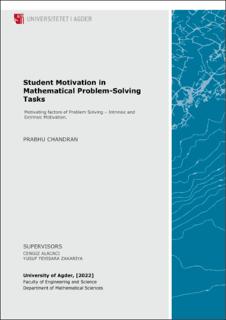| dc.description.abstract | Students from the school are our future. Therefore, it is essential that teachers, who are part of the school, encourage the students to use their full potential. To do this, teachers need to make their students find the schoolwork satisfying and enjoyable and also something useful for their future. One of the important tasks for an educator is to motivate their students to develop the willingness to learn.
This study involves a combination of both quantitative and qualitative approaches that examine what kind of motivating factors can influence the motivation for problem-solving of students based on the rating of the tasks and their ability to solve tasks by them. The study has been conducted in two grade levels at a lower secondary school (International Baccalaureate) in Southern Norway and is based on systematic data collection through Likert type questionnaires, text comments and audio recordings. The empirical material consists of a data collection instrument and post-session interviews.
The result of this study shows that both intrinsic and extrinsic motivation is crucial for problem-solving. Visuals can be one of the most prominent motivation attributes behind problem-solving. In this master’s thesis, I have also concluded that the motivating factors for different age groups of students can differ. The results also underline the importance of intrinsic motivation in problem-solving. | |
